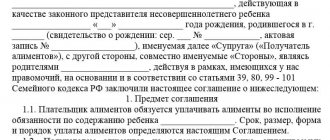Content
1. How to apply for alimony in an official marriage?
2. Advantages of ordered collection of alimony
3. The procedure for collecting alimony payments through a judicial authority
4. How to draw up a statement of claim for alimony?
5. Timing of the trial for alimony payments
6. When can an adult request child support payments?
7. Punishment for malicious evasion of alimony
8. In what situations does the court refuse the plaintiff?
Russian legislation equalizes the rights of spouses to a common child, but a stamp in a passport does not make the father or mother more responsible towards the children. Sometimes one of the partners (usually the father) does not divorce his wife, but at the same time does not contribute to the family budget, is not interested in the children, does not monitor their upbringing, does not make important decisions regarding the health or education of the children, and does not live in the family. In these cases, you need to file for alimony without getting a divorce.
When do you need to file alimony?
The situation when alimony is collected during a marriage or after a divorce is quite typical. The most common reasons for filing for enforcement are:
- Evasion of the child's father from child support after divorce;
- The husband's refusal to support the child. Unlike those situations where the ex-husband stopped paying alimony, partners in an existing marriage, even without a divorce, often shirk their obligations to support children.
- The birth of children from a second marriage in the presence of alimony obligations from the first and the spouse’s evasion of their maintenance.
- The actual termination of marital relations or living in a civil marriage with the subsequent birth of a child recognized by the father, but left without support. The spouses do not live together, but the husband and father of their common children refuses to support them.
Note: The collection of alimony is often used to “optimize” alimony payments and reduce them in cases where child support has been collected from the father from his first marriage. After all, the birth of children from a second marriage does not entail automatic distribution of alimony between them. Learn more about ways to pay child support.
We recommend that you seek a free or paid consultation with our lawyers before applying for alimony. Perhaps you really need it or it makes sense to resolve the dispute amicably.
Advantages of ordering the collection of alimony
Ordered collection of alimony is not much different from a settlement agreement between spouses during a divorce. The essence of this order is this: the husband agrees to pay alimony for the minor, visit him on “parenting days” and take him on vacation, and play a significant role in the child’s life. Also, a man does not mind divorcing a woman if he does not live with her.
The plaintiff's alimony claims may include:
- Calling and hearing witnesses.
- Providing evidence base – information is already presented in documents.
- Sometimes the appearance of one of the spouses. The court, without their presence, studies and analyzes the materials, makes sure that the plaintiff needs it, and issues a verdict.
- Failure to comply with the order: the defendant a priori will not change addresses, hide his place of work and income, or doubt paternity.
- Involvement of law enforcement agencies.
- Parallel claim proceedings with its specifics such as attracting parties and calling witnesses.
The order is issued to the plaintiff, and in exceptional cases to the bailiffs, since we are talking about voluntary recognition of obligations. This document contains the amount of alimony - percentage or fixed, payment terms. The debtor has the right to express disagreement within ten days, but such precedents are rare. After ten days have passed, the document acquires legal force and becomes binding.
How will alimony be collected after it is issued?
Child support is collected on the basis of a court order or writ of execution, which is handed over to the bailiffs for execution. It is also possible to receive payments directly from the payer if he agrees with the decision and is ready to implement it voluntarily.
Also, the claimant can independently present the sheet to the debtor’s place of work so that the accounting department can calculate and withhold alimony. If alimony was collected as a share of income, and then the payer lost his job, then the bailiffs will calculate payments based on the average salary in the region. But this is only possible if the payer is not registered with the Employment Center. Otherwise, deductions will be made from unemployment benefits.
Similarly, it is permissible to collect alimony from a married spouse if they do not comply with the provisions of the law on supporting each other in the event of the disability of one of the spouses.
The procedure for collecting alimony payments through a judicial authority
If a woman has sent an application to the court to collect alimony from her official husband, it means that the option of concluding a settlement agreement is not for her. It is difficult to come to an agreement in a civilized manner with a person who does not live in a family without divorcing the child’s mother. The trial may be:
- Orderly . It involves the mother receiving an order. But in this case there should be no disputes regarding the paternity or place of residence of the child.
- Iskov . It involves lawsuits, disputes, testimony, evidence, DNA analysis, etc.
The deadline for filing an application has certain restrictions - the common child must be under 18 years old. The statute of limitations for pursuing a defaulter lasts three years.
Notarial agreement
The issue of collecting alimony is always exciting for both spouses. At this moment, you need to take a very responsible approach to all issues in the design.
If the parties want to resolve all differences peacefully, then a settlement agreement can be drawn up. It can spell out any agreements that the spouses come to.
Remember that the amount of alimony in the agreement must be higher than the one that would be assigned in court. You can specify in the agreement any amount that the debtor will be required to pay as child support.
In order to determine where to submit documents, you need to clarify several questions:
- Are the parties ready to communicate and negotiate with each other?
- whether the marriage was officially concluded or not;
- are the parties currently divorced or married;
The answers to each of these points will determine where you need to submit your application and other papers.
How to file a claim for alimony?
A claim against an official husband who does not fulfill parental responsibilities is no different from a claim against a former spouse. It contains:
- Name and legal address of the court.
- Full name of the plaintiff and defendant.
- The main part, consisting of the essence of the question: when and in which registry office the marriage was concluded, the number of children under 18 years of age, since what period the husband has not lived in the family and shied away from parental responsibilities.
- Legislative framework, links to norms, acts and articles of the Family Code of the Russian Federation, confirmation of the legality and adequacy of alimony requirements.
- The actual requirement is to collect alimony.
- List of attached documents.
- Date and signature.
List of documents attached to the claim:
- Passport or a copy of the plaintiff’s passport, other identity document.
- Copies of the child’s birth certificate.
- A copy of the passport of a child over 14 years of age.
- A copy of the document confirming the marriage.
- Extracts from the house register about family composition.
- Confirmation of the absence of divorce.
- Information about the welfare and income of the parties.
- Justification of the adequacy of the required amount in the form of documents, checks and statements.
The number of claims must coincide with the number of participants in the trial - for the court, the plaintiff, the defendant, and third parties.
The court can help collect documents for the trial and the evidence base on the basis of a petition (Article 57 of the Code of Civil Procedure of the Russian Federation). However, it is better to contact a lawyer and, with his help, demand a certificate from the defendant’s place of work or look for his new place of residence. In this situation, a woman chooses which court office she should contact - at her place of residence or at the “new address” of her official husband.
The plaintiff has the right to demand payments as a percentage of the defendant’s salary: 25% for one child, 34% for two and 50% for three, four, etc. The husband should remain 50% for life, regardless of the number of children. If a fixed amount is required, you need to prove it: indicate the expenses for the child. It indicates how much is spent per month on food, education, care, health, entertainment, hobbies and additional activities. Receipts must be attached.
A fixed amount justified by the needs of the children is an excellent way to recover money from a person who does not have permanent employment and does odd jobs. Also, the maintenance of a disabled spouse or a forced-unemployed mother is deducted in a fixed amount.
Keep in mind: money is collected not from the moment the child is born or the child is diagnosed with a disability, but from the date the claim is filed. It is better not to delay your appeal to the courts, and an experienced lawyer will help you defend your right to a comfortable life, and your child’s right to a prosperous childhood.
The right to alimony terminates: when a child reaches three years of age (for his wife), when a child turns eighteen, when the statute of limitations expires, when a diagnosis is removed, or when a pregnant wife gives birth.
Methods for obtaining alimony
Alimony payments are money that a parent pays to their child for upbringing and maintenance. There are several ways to obtain alimony. Let's look at these methods in more detail:
Pre-trial registration. This method of alimony registration is suitable for those parents who have come to a peaceful agreement on a monetary issue. Parents can independently agree among themselves on a certain amount of money that will be paid to the child monthly.
Registration through the court. This method of alimony registration is suitable for those parents who cannot come to a peaceful resolution to the issue. In this case, a statement may be written to the judicial authority.
If we talk about which method is better, then, of course, the best option would be to reach an agreement peacefully. In this case, there will be no need to run around the courts, argue, waste time and effort. But if it is still impossible to resolve the issue peacefully, and alimony is necessary for the child, you should go to court.
Litigation period for alimony payments
The timing of a court decision depends on what kind of process it will be - a claim or an order.
- The writ court lasts only five days, since the spouses will soon divorce without disputes, conflicts and claims. Sometimes it can be done without calling a party to a meeting.
- The lawsuit lasts at least a month with the obligatory summoning of the parties to court by summons. With a court order, the plaintiff must contact the bailiffs or the accounting department at the enterprise of her legal husband.
How to find out your alimony debt on the Internet?
The Internet makes it easy to check the existence of alimony debt and its amount on the Internet, not only to persons who are obliged to pay payments, but also to their recipients. To do this, you can use one of the sites - the bailiff service portal or the government services website (including using a mobile phone).
- To find out your debt on the FSSP website, you just need to enter your first and last name.
To do this, you need to go to the “Territorial Bodies” section and select your location, then find the “Data Bank of Enforcement Proceedings” section and enter your data into the search. The database will provide all the necessary information regarding debt payments, as well as the bailiff’s contacts if additional information is needed. - The State Services portal allows only registered users to view debt. But registration does not take much time. After authorization, go to the “State Electronic Government” section, select the authorities we need and find information on the debt.
- You can now get information about debt even on social networks - “on Odnoklassniki” and “VKontakte”.
To do this, you need to install the “Bank of Enforcement Proceedings” application. Using the application, you can regularly receive the necessary information about debt accrual and changes in debt. At the same time, the program will send notifications on its own, so you won’t be able to forget about the accumulated debt.
When can an adult request child support payments?
Not only children under 18 years of age have the right to regular child support payments. It could be:
- Pregnant woman.
- A woman caring for a toddler until the child reaches three years of age.
- A mother caring for a disabled child. In this case, the woman is involuntarily disabled and cannot earn money to cover her daily needs. The age of a child with an incurable disease is not limited to eighteen years if he has a proven first group of disability.
- A disabled spouse whose incapacity for work has been proven in court.
- A disabled child of any age.
Legal procedure
Let's take a closer look at how the procedure for judicial registration of alimony occurs:
- First of all, the parent who will be the plaintiff must write an application to the court. The application must contain a request for alimony payment or a request for the issuance of an order.
- Next, the plaintiff must collect basic documents as well as evidentiary documents.
- After collecting documents, they are submitted along with the application to the judicial authority, which is located at the place of residence of any of the parties to the legal dispute.
- After this, a court hearing will be scheduled in which the plaintiff will have to prove his position.
- After the hearing, the judge will make a decision, or issue an order.
- The final stage will be the transfer of the writ of execution to the place of work of the alimony payer. Or the writ of execution is given to a bailiff who works at the defendant’s place of residence.
Punishment for malicious evasion of alimony
Important: Refusal to support a minor child is punishable by administrative or criminal penalties. Also, penalties and fines are imposed on the “body” of alimony payments for late payments.
Here is a partial list of sanctions, administrative and criminal:
- Prohibition to drive, deprivation of license.
- Prohibition to leave Russia.
- Seizure of accounts and property that may be seized in favor of the plaintiff.
- Deprivation of parental rights. It is worth noting that this will not relieve the defaulting parent from child support obligations. According to the law, he will lose not his responsibilities, but his rights - the opportunity to live in an apartment registered to the child, communicate with children, spend time with them, educate them, influence them and shape their worldview.
- Serving a sentence in MLS.
How is a voluntary agreement concluded?
As mentioned above, the child’s parents can formalize a child support agreement on a voluntary basis. Let's consider this procedure in more detail:
- First of all, parents must peacefully agree on all the conditions that relate to child support for a minor. The parties must decide what amount will be paid, in what manner and when the money will be transferred.
- After this, parents must complete the document in writing.
- After drawing up a written agreement, you need to collect the necessary documentation package. This includes the main documents listed above. Certificates of parents' income will also be required.
- Lastly, the agreement on alimony payments and the list of collected documents must be submitted by the parents to the notary’s office. The notary will check the correctness of the document and certify it. After this, the agreement will have legal force.
That's the whole registration process without the participation of the court. This method is fast and affordable.
Who can demand and when can a mother achieve?
To collect alimony, the legality of the marriage and the joint or separate life of the parents are not important. The following may request child support for a minor child:
- a divorced mother or father who lives with and supports the child;
- a legally married wife or husband can collect and receive alimony for a minor son or daughter in cases where the other spouse living in a common living area stops giving money for running the joint household;
- one of the cohabitants previously living in a civil marriage may demand financial support for their common son or daughter.
A legally married spouse will have to prove in court the refusal of the other parent to give money for their son or daughter. Payment documents confirming individual expenses are provided to the court (receipts for payment for kindergarten, receipts for the purchase of children's goods and food, etc.) or witnesses are invited to confirm this fact.
Attention! A child born in a civil marriage has the same rights as a child of legal spouses.
For a boy or girl born in a civil marriage, proof of relationship will be a birth certificate with information about the father entered on it. If there is a dash in the “father” column and the man does not want to voluntarily recognize the child as his own, then the woman will have to go to court to order a genetic examination and recognize the defendant as the father.










